WELL-BEING


Wellness | 1
How agile furniture and fluid spaces support student
ELEMENTARY SCHOOLS
2 | VS America, Inc.
In elementary school, flexible environments improve the quality of interactions between students and students and teachers. Agile furniture can create various spaces and zones within a classroom - this flexibility means more freedom for social integration and movement opportunities. Flexible environments give teachers the needed areas to deliver private actionable feedback, support students’ selfselecting learning locations, and offer multiple modes of formative assessment.
Student-centered learning aims to develop autonomous and independent students. Agile furniture contributes to individual freedom of choice. The freedom to choose personal and situational comfort sets the stage for developing agency in the learning environment. Agile furniture is paramount for quick autonomous changes. In these environments, students can appropriate the types of spaces and furnishings that best support their learning. When flexible environments are supported by agile furniture, it shifts the learning experience from the teacher to the student.

Wellness | 3
Flexible spaces maximize the interplay between positive learning outcomes, physical wellness, and self-regulation.
4 | VS America, Inc.
Well-designed environments that advocate social and emotional well-being promote equity and inclusivity, leading to overall improved learning outcomes.
When teachers cultivate student-centered environments in their classroom, it does not mean kids have free rein to do what they want. It means a structured environment with routines and procedures so all kids can learn. The goal is to holistically marry learners’ academic, social, and emotional needs as they seek answers to the wonders of the world around them.



Teachers who utilize agile spaces foster a community culture by allowing independent work and teamwork through large and small


group instruction and reflective, independent learning activities. It means placing students at the center of their own learning environment so they can decide why, what, and how their learning experience and environment will take shape. It is designed for learners to engage in collaborative experiences, so they have multiple opportunities to demonstrate mastery through skills and content. Flexible environments are multidirectional to support the acquisition of learning outcomes and help teachers address any learning losses as needed.

Wellness | 5
VS America’s agile furniture can be used to create flexible learning environments. Teachers and students can easily arrange various spaces and zones to allow for increased movement, social integration, and content-based interactions.
6 | VS America, Inc.
Social integration with line of sight throughout the classroom accompanied by acoustical supports by incorporating soft furnishings.
Micro-collaborations with peers in physical and virtual breakout spaces.
Place identity, in-person and distance learning, through selfselection of tables and chairs and mobile storage to arrange literacy-based dialogue circles.
Student participation with the incentive to belong in the physical environment when they have agency to choose, move, and be comfortable.

Wellness | 7
Flexible learning environments with agile furniture support instruction in whole group, small group, and in one-on-one spaces. The various types of groupings foster the following opportunities:

1.
Whole group instruction allows the teacher to create cultural, community, and social-emotional connections.

3D Tour
2.
Small group experiences promote positive interdependence, individual accountability, and social interactions to help make meaning of a text.
3.
Distributed mobile storage helps teachers allocate classroom resources based on rotations, and also offers privacy for one-on-one instruction.

4.
Small groups foster social belonging through interactive peer supports and promote the love of learning.
INDEPENDENT READING
10 | VS America, Inc.
Culturally inclusive classroom libraries with rich texts develop students’ vocabulary and reading fluency.
Independent reading is about students finding joy in their reading selections, being curious about the characters, and exploring topics they are passionate about.
After independent reading, invite students to share what they are reading about - including characters, settings, and various themes. Teachers can glean insight about students’ interests by debriefing in socratic dialogues using literacy concepts and skills. This helps ensure that children develop critical foundational

literacy skills such as comprehension and vocabulary.

Wellness | 11
Independent reading as a regular habit in comfortable, supportive settings promotes student agency, lifelong reading, and language acquisition.
Giving students dedicated reading time helps strengthen their reading abilities. Flexible seating options provide students the opportunity to self-appropriate different types of seating. When we give students agency to grab a book, get comfortable, and change positions we can foster their curiosity for nonfiction or spark their imaginations through fiction.
1.
Flexible seating provides educators and other educational specialists who flow in and out of classrooms throughout the day with various spatial layouts to support personalized literacy skill-building.

2.
Intentional shelving provides not only spatial separation to help define solo spaces for independent readers but also provides easy access to diverse and high-interest books for all reading levels.
3.
A sense of solitude can help readers stay focused by reducing distractions, and also support wellness by providing quiet time before or after collaborative activities that occur throughout the day.
4.
5. Creative storage options provide on-demand tools and resources for language acquisition.
A variety of seating options in the learning environment means students are able to define a solo space using furniture. Solo spaces help readers with a sense of ownership and solitude.

GUIDED MATH WORKSHOPS
14 | VS America, Inc.
Workshop teaching is an effective way to differentiate instruction for the wide variety of learners in the classroom. Guided math workshops is an example where students learn to take ownership of their daily math routines and develop self-directed learning skills.
Agile learning spaces allow students to quickly set-up and comfortably engage in math workshop model routines. It gives teachers more time for observing student progress toward


mastering concepts and identifying students with misconceptions or gaps in understanding.
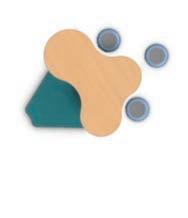


Flexible student combinations have the potential to relieve math anxiety and learning loss through differentiated groupings and one-to-one seating options. Tables that allow for standing are perfect for students working in groups, and fliptop tables can provide sound barriers. Mobile storage enables teachers to create zones and allocate resources and manipulatives to these zones.
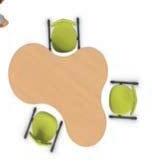
Wellness | 15
Student-centered environments empower students to interact, work, and collaborate effectively with others. These basic, important skills are needed for learners to process and make meaning through group work, reflection, and teacher feedback.
Like reading, competence in mathematics depends on appropriate and practical instruction with many opportunities to share, actively apply concepts, and reflect using academic language. Agile learning environments with flexible seating options allow students to collaborate as mathematicians. They can strategize, reason, work, and communicate their understanding with peers and teachers. With flexible furniture, various math activities can happen simultaneously, with students easily moving around using writable surfaces to share thinking.
1.
Agile spaces optimize the learning environment and increase the opportunities to visualize the learning process.

2.
Writable surfaces throughout the classroom give teachers a way to visualize, using academic language, expectations for each learning station. They also provide surfaces for students to express their procedural knowledge in writing.
3.
Working collaboratively with flexible standing, sitting, and floor options allow students to work through complicated and more conceptually difficult math problems, while the teacher moves around to observe and provide real-time support to each group.
4.
A mix of tables allows the teacher and students to simply rearrange the classroom space to take half of the students and dig deeper into the math lesson with a smaller group. The other half of the class participates in learning stations, and then the two groups switch.

LITERACY LEARNING STATIONS


18 | VS America, Inc.
Literacy centers are physical areas or stations set up for students to work independently or collaboratively for specific learning purposes, such as meeting literacy goals. Learning stations are designed to provide appropriate materials, be mobile, and can be both temporary or permanent. With agile furnishings, teachers can quickly implement literacy stations with multiple group configurations while simultaneously engaging in direct one-to-one instruction.
A single classroom has a wide range of independent literacy abilities. They range significantly, including English language learners, gifted students, and those with special needs. During literacy stations, students rotate through specialized zones where they focus on literacy-based activities in small groups or independently, while the teacher has the opportunity to pull individual students or small groups for targeted literacy instruction. Targeted reading instruction helps learners
develop self-regulation skills and allows them to make text-to-self connections, while exploring individual and community identities through stories.





Schools and teachers can meet the broad and various needs of their diverse learners more effectively in classrooms with flexible furniture. When teachers can flexibly arrange their space, they can efficiently gather data, progress monitor for content mastery, and assess learning loss in both fluency and comprehension skills. This type of agility in the classroom helps teachers personalize and differentiate their literacy instruction.



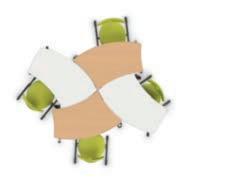


Literacy learning stations in motion: let’s walk through an elementary classroom using VS America’s agile furniture...

Wellness | 19
1.

First, a teacher engages the whole group of students in a shared reading exercise. The students come together in front of the teacher using various soft seating options, Hokki stools, and sitting on the floor.

2.
After the story, students participate in a literacy minilesson for 10-15 minutes. The mini-lesson prepares students to then move into literacy stations. There are designated or selfselected zones for independent reading, reading buddies, and small group conferencing with the teacher.

3.
Agile furniture means students scatter to various independent reading spaces throughout the classroom with soft seating. Reading buddies move to designated zones with Shift+ ThumbPrint tables arranged for students to engage in specific paired reading dialogue activities. The teacher holds reading conferences in the classroom library which provides privacy and acoustical support for their one-to-one conference.



4.
Students rotate through independent reading, reading buddies, and meeting with the teacher over a specific time period. Students have the autonomy to change positions, stand, sit, wiggle, and bounce because minds and bodies are always in motion.
7.
While this is happening the teacher is able to meet with a student about a sensitive matter privately in the nook space provided by curved bookshelves and soft seating of the classroom library.


6.
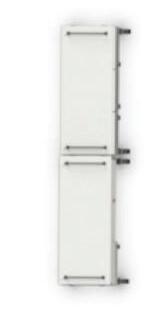
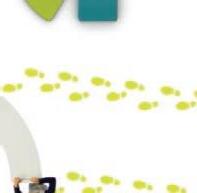



At the end of the 50 minute time period, students move the classroom back to the original zero space set up before leaving for specials in another part of the building.

5.

Finally, the teacher brings the whole group back and closes with a debrief of the activities. Students again use soft seating and Hokki stools to listen to the story. Students fidget, tap, and squirm comfortably on the variety of seating options while actively participating.
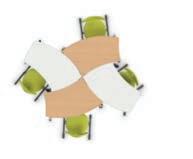


LESSONS IN MOTION:
4th Grade Social Studies with Embedded Science and Literacy
1. Teacher welcomes or transitions students into the next learning experience.
2. Learners either find their assigned teams or start within their rotation teams from table assignments.
3. Teacher reviews learning station agreements and goes over each learning station procedure. (15 minutes for explanation and 60 minutes for rotations over a three or four day period.)
4. Learning station rotations include:




A. Reciprocal Reading Station: for comprehension with 4 column question graphic organizer and team role playing cards. Learners can use tables or sit in a circle with chairs.
B. Inferences and Conclusions Station: virtual field trip on regions and landforms. Students flip writable tabletops to use as a note-taking station.
C. Landform Model Construction Station: students work in pairs to construct a model of a landform using pizza boxes and art materials. Students use soft seating and classroom libraries. (Chairs can be pushed against the wall.)
D. Landform and Erosion Science
Experiments Station: Blue Planet water lab.
5. While students work through their stations, the teacher monitors various stations to ask inquiry questions, provide immediate feedback, anecdotally assess misconceptions, and support online breakout teams.
6. End of the three or four days of rotations conclude with landform pizza boxes designs where teams appropriate/self-select work areas and rearrange room to complete the project.
7. Student work session ends with a whole class zero space clean up followed by a reflection protocol in their social studies journal.
8. Landform presentations to follow with complete room arrangement for presentations after landform unit lessons complete.
24 | VS America, Inc.





Jill Ackers has taught and consulted with schools and organizations worldwide to transform various learning ecosystems for the 21st century. As an educator with 20+ years of experience, she brings her passion for constructivist learning, languages, and technology to educators through authentic, relevant learning and professional development. She has launched new schools, been a school leader in both private and public institutions, and taught in PreK-12 programs. She started and led for six years, the first Dual Language Project-Based Learning School in Dallas, Texas. She has redesigned university professional development programs across the country including Sam Houston State, North Central University, and was a founding designer for Southern Methodist University’s (SMU) first urban transformational leadership master’s program and trained principals in school turn around. She helped design SMU’s Lyle School of Engineering Teacher project-based learning training institutes. She actively writes universitylevel courses and trains university professors in experiential education and digital workforce advancement. Jill’s current school ecosystem projects include schools in Singapore, Spain, Colombia, Rhode Island, and New York. She facilitates and designs PBL Learning Community Pathfinders across the country and internationally for Fielding International.
RESOURCES:
To access all resources scan QR code or go to https://bit.ly/vs-wellness-resources

See other classrooms come to life in the VS virtual classroom at https://www.vsshowroom.com/elementary
Learn more about how VS supports student well-being at https://vsamerica.com/student-wellbeing
What is a Design Pattern? - Design Patterns are simple sketches and annotations that get down to the essence of how a space works. These key ideas break down the complexity of school design as part of a system.
https://fieldingintl.com/design-patterns/
Sustaining Student Learning and Success: a Holistic COVID-19 Response Strategy Published on Oct 17, 2020
https://bit.ly/vs-covid-response
Learning from Teaching in Literacy Education

https://www.heinemann.com/products/e00483.aspx
Learning About Building Literacy Communities in Multicultural and Multilingual Classrooms From Effective Elementary Teachers
https://files.eric.ed.gov/fulltext/EJ966162.pdf
Spaces in Motion: Designing Healthy School Environments
https://bit.ly/spacesinmotion
26 | VS America, Inc.
Jill Ackers, ALEP Senior Learning Designer
Wellness | 27
28 | VS America, Inc. VS America, Inc. | 1940 Abbott St. Charlotte, NC 28203 | Phone: 704.378.6500 www.vsamerica.com facebook.com/vsamericainc twitter.com/vsamerica instagram.com/vs_america youtube.com/vsamericainc art no. PROD 3/01/22 V09




































































